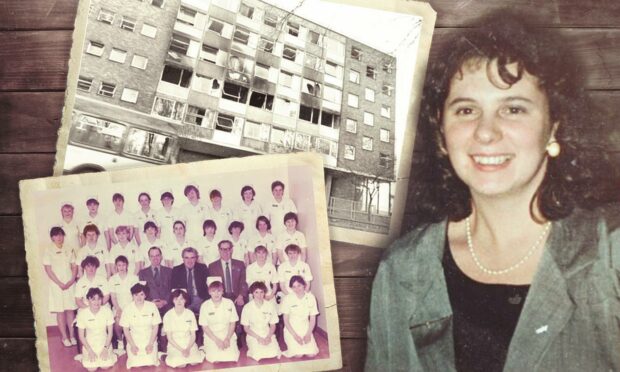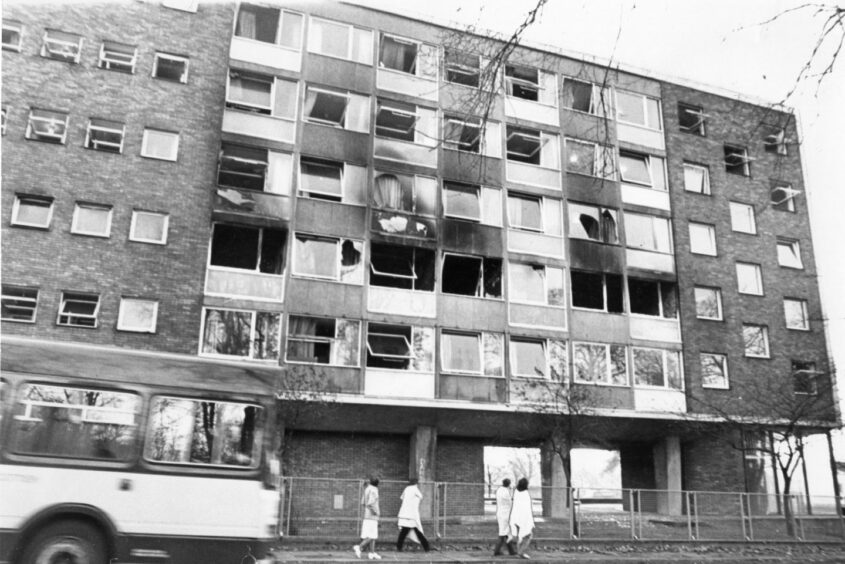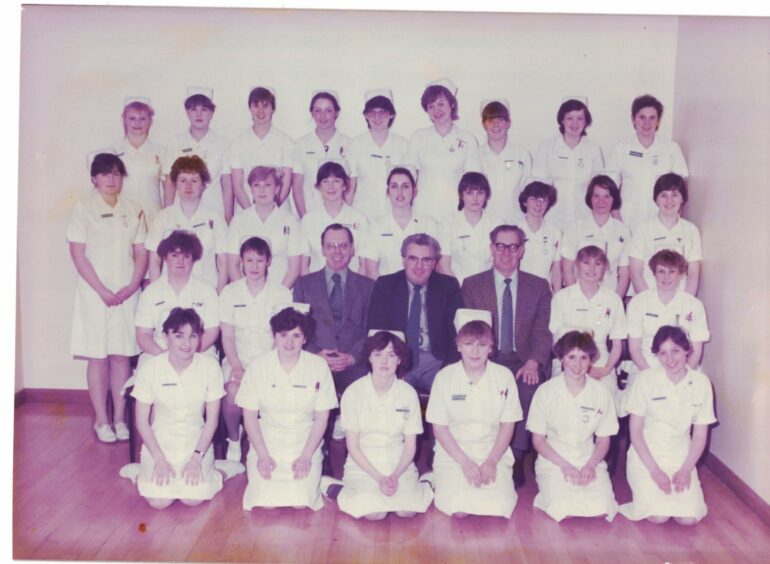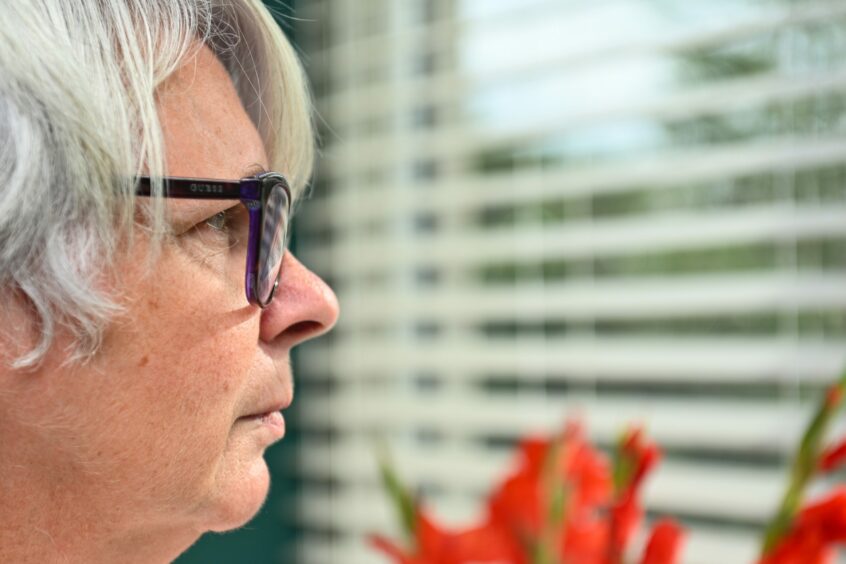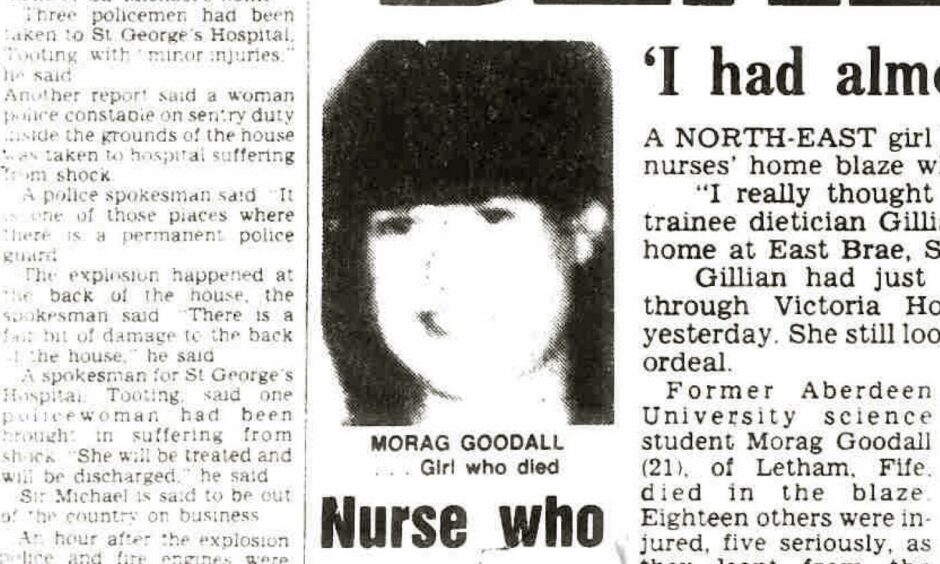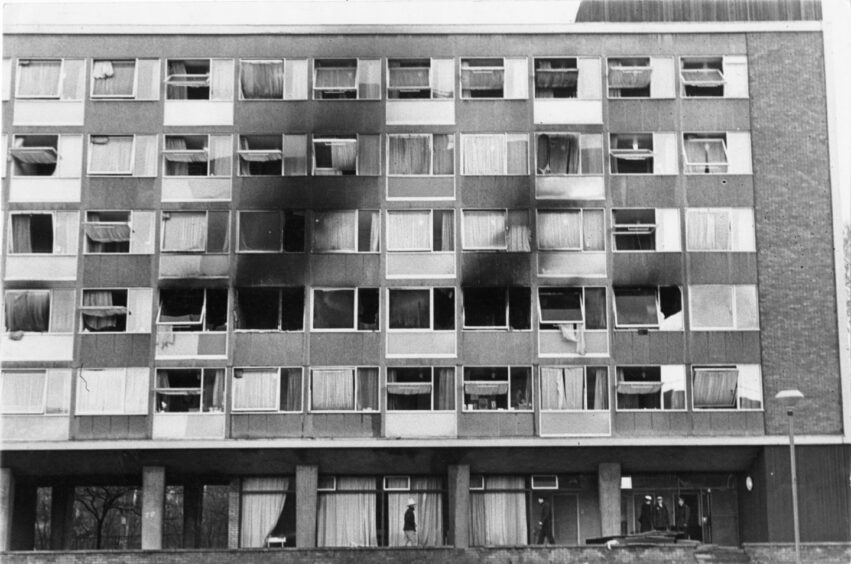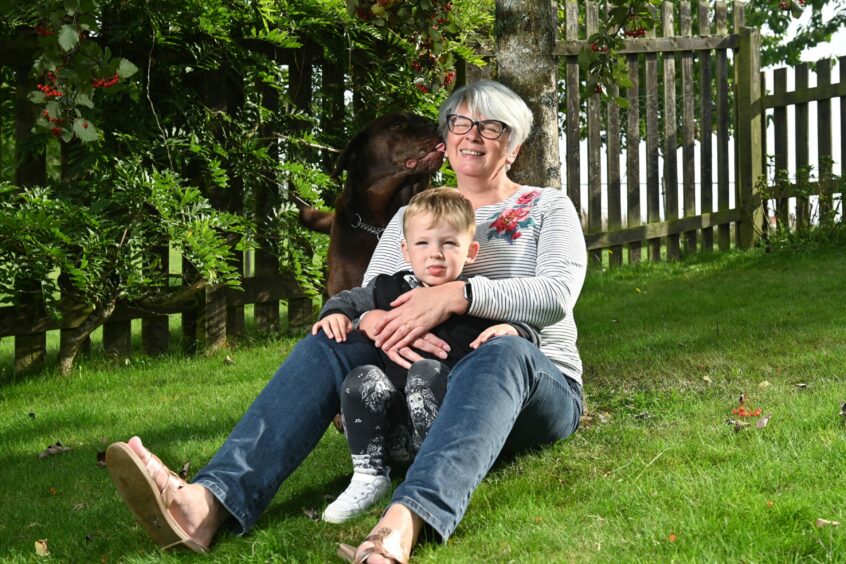“My room was now filling with smoke. I hurled my mattress out of the window. I had no choice but to jump.”
Brenda O’Neill (nee Jamieson) leapt from the nurses’ home at Victoria Hospital in Kirkcaldy to escape the thick black smoke which engulfed the building on November 13 1981.
The six-storey block was occupied by 51 of the 82 residents at the time of the fire.
Eight people were seriously injured when jumping and 12 others were slightly injured.
Seven occupants were rescued by firefighters.
Former Aberdeen University science student Morag Goodall died.
She was 21.
She was caught in the corridor when the fire suddenly erupted on floor C.
What happened?
Some nurses had been in the common room on B floor and decided to investigate after becoming aware of some banging noises coming from above.
One of them heard a very loud thump.
They discovered the corridor on C floor full of smoke.
By the time the alarm was raised around 1am the fire had grown to such proportions that several of the occupants had to jump to escape the inferno.
Survivors like Brenda have spent the past four decades wrestling with the physical and emotional trauma of what happened.
Brenda was 19 at the time and went to sleep as usual.
She woke up later to the sound of fire on C floor and has now spoken publicly for the first time ahead of this weekend’s 40th anniversary.
“It was just an ordinary Thursday night,” said Brenda.
“I was off and meant to be in work the next day on early shift.
“I remember being woken by a funny noise in the corridor but nothing registered.
“Then the fire alarm went off very briefly on C floor.
Who goes to their bed at night and wakes up with their building on fire?”
Brenda O’Neill
“They were all wired to the one fuse box – once that burned they all stopped.
“But it was thankfully enough to alert us that there was a problem.
“I opened the door and the corridor was on fire.
“I couldn’t believe what was happening.
“I could hear people shouting.
“I went back inside and put a wet towel below the door.
“I ran to the window of my bedroom and realised things were getting serious.”
Brenda leaned out of the window and saw mattresses being thrown to the ground.
“One of my friends jumped and afterwards her window just blew out,” she said.
“Flames were pouring out of her window.
“The difficulty was: the fire engine could only reach the girls on the other side of the building because of access so we had no means of escape.
“My room was now filling with smoke.
“I hurled my mattress out the window. I had no choice but to jump.
“I didn’t know if the ceiling or the floor would collapse.
“There was a bar across the bottom of the window and I hung on as long as I could.
“I let go but I hit the ledge above the front door and landed on the concrete.
“My right side took the brunt of the fall.”
Brenda was lying on the ground while the building burned above her.
“Who goes to their bed at night and wakes up with their building on fire?” she said.
“It just wasn’t sinking in how badly injured I was.
“It gradually dawned on me the next day.”
She was eventually taken to the Vic with serious injuries.
“I was completely black with the soot and the smoke,” she said.
“It was pure survival instincts that kicked in that night.
“Nothing would have made me go out that window until I knew I had no other choice.”
Brenda was put in traction for the first four weeks, after suffering a broken pelvis, broken hand, smashed elbow and cuts and bruises.
Elbow surgery followed, which still gives her problems to this day.
She spent her 20th birthday in hospital and the chance to say goodbye to Morag, whose funeral was held at Monimail Church near her home in Letham.
“Morag was a nice, bubbly girl,” said Brenda.
“She turned 21 that summer and she was engaged to be married.
“She was like the rest of us – enjoying life and looking forward to her future.
“At that age that’s what you do. You just hope it turns out well.
“Most of us were 17-19 and we were all working at the hospital.
“We worked hard but we also enjoyed ourselves.
“We would socialise together in Lister’s Bar and go to the disco.
“There was a real sense of camaraderie among us and life was good at that time.”
Brenda lost all her belongings in the fire including photos with those fellow nurses and the ring that was given to her by her parents to mark her turning 18.
Inquiry lasted months
The home’s fire precautions at the time consisted of the recommended provision of fire escapes, stairways, fire doors, fire extinguishers and ‘break glass’ fire alarms.
A 31-page judgement by Sheriff Principal Robert Taylor QC was published in 1982, following a 15-day fatal accident inquiry at Kirkcaldy.
Finding that the blaze started in the second floor, near or in a telephone area, Sheriff Principal Taylor stated: “The origin of the fire remains a mystery.”
He blamed the “improper use of combustible ceiling linings” in the building for the death of Morag, who forgot there was a fire exit next to her room.
He found that open fire doors on the second, fourth and fifth floors – wedged open for the convenience of using phones – were a subsidiary cause of the rapid spread of the fire and led to girls being trapped, but did not contribute to Morag’s death.
Brenda went back to work following her recovery and managed to catch up with her studies before eventually graduating in November 1984.
“This was 1981 and nobody really recognised PTSD and how to treat it,” she said.
I’ve been lucky enough to live a good life and the fire made me do that.”
Brenda O’Neill
“The good thing was: we were still together and we helped each other through.
“I think everyone in the hospital was affected by what happened and they were all very supportive and we were very well looked after.
“We were put up in hotels and halfway houses to start with, which is where a lot of the healing happened because we were by ourselves and got through it.
“We do meet up occasionally and I always think about how they are all doing.”
‘Make the best of this’
Brenda, who grew up in Moray, enjoyed living and working in Fife until moving north in 1991 when her husband was posted to RAF Lossiemouth.
The fire could never dampen her love of Fife or its people and she decided from an early stage that she wouldn’t let it define her or, indeed, consume her.
She will return to the nurses’ home, now Hayfield House, today, where a small ceremony will be held and a plaque unveiled to mark Morag’s passing.
“Of course, it’s always there in the back of your mind,” she said.
“Every time I go into a new building I’m looking to find the fire escapes – I’m looking at the windows and thinking: ‘How would I get out of here if there’s a fire?’
“For quite a few years I was working in a building that was similar in age and style to the Victoria Nurses’ Home and I was very much aware of that.
“But it doesn’t consume me and I decided I wouldn’t let it.
“In those early months there were times when I’d wake up and I was scared but over the years you get on with it.
“I’ve been so lucky – it could have been so different.
“I might not have been able to walk away.
“I’ve been lucky enough to live a good life and the fire made me do that.
“It made me think: you’re lucky so make the best of this.
“If it hadn’t happened I wouldn’t have made decisions I went on to make so my life might well have turned out differently.
“But I’ve had a good life.
“I wish it hadn’t happened and I am grateful that I survived and moved on.”
